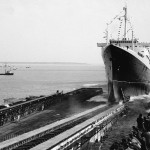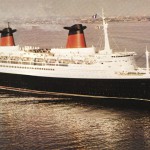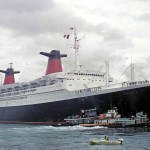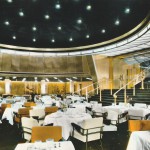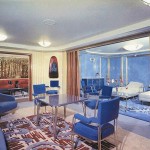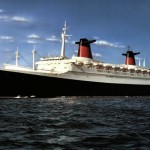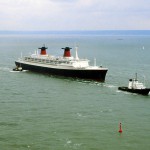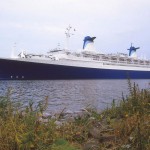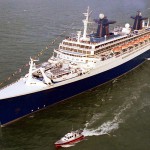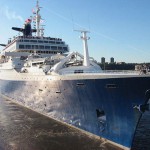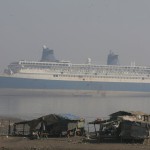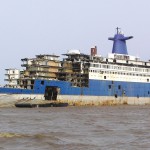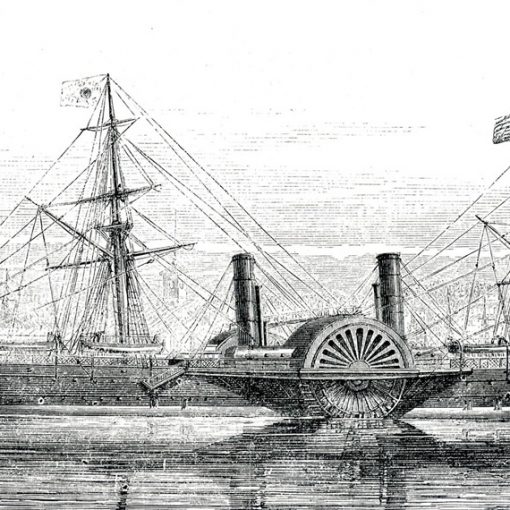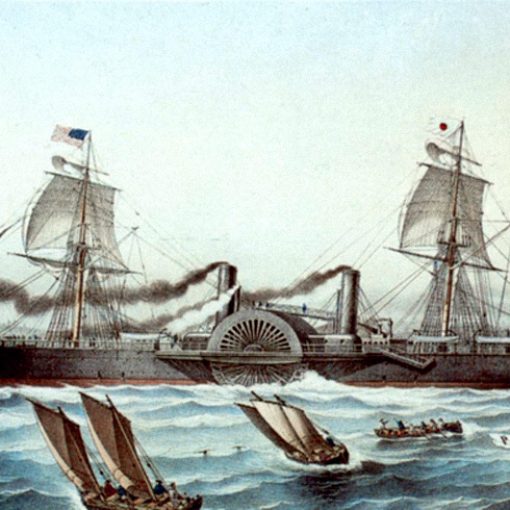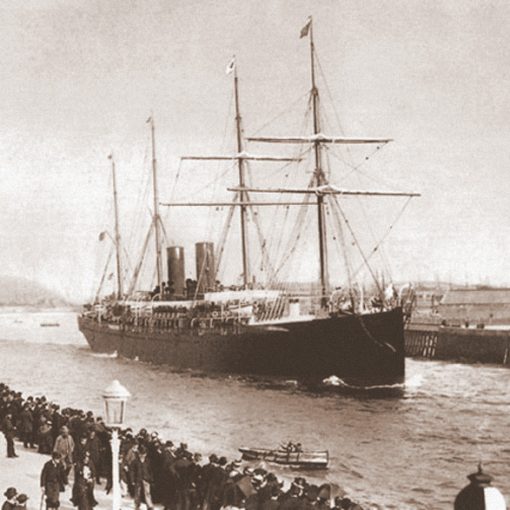1962 – 2006
Also known as Norway
By the 1950s the French Line had been put in a rather difficult situation. Their prime ships were the distinguished Île de France and Liberté, who both began to grow old. It was realised that these two liners would be scrapper’s victims within the decade. But the French needed to compete with foreign shipping companies and without these ships they had no cards to play. The 1939-built Pasteur was considered to be put into trans-Atlantic service, but this would not be enough.
To make matters worse, the British spread rumours about a planned 75,000-ton replacement to the Queen Mary and Queen Elizabeth. Even the Americans seemed eager to realise a long-time wanted project – a sister ship to the speed-champion United States.
The first French thoughts about an answer to these ships were to construct two 35,000 gross ton vessels to operate on the North Atlantic. However, these plans were given up at the second half of the Fifties. At this time, France was suffering from the pain of releasing yet another of its colonies – Algeria. President Charles de Gaulle thought that the perfect medicine for the dismayed French was one, large and stunning superliner that would help France to re-establish itself in the eyes of the foreign world. Like the stunning Normandie of 1935, this new liner would have to be a showpiece and a morale builder.
On July 26, 1956, a new vessel was ordered by Compagnie Générale Transatlantique to the famous Chantiers de l’Atlantique shipyard in St. Nazaire. The demands of the French Line were not small. The liner should be the longest ever constructed, and certainly one of the fastest. This not only meant that the ship needed powerful machinery, but also that Chantiers de l’Atlantique had to prove their skill in producing a hull that could live up to the demands of a pounding sea at high speed. This ship had to be something special, both for the sake of France and for the fact that it would replace not one, but two much loved grand dames of the oceans – Île de France and Liberté.
Work began on September 7, 1957. Chantiers did not use the conventional way of building a liner; by first framing a whole ‘skeleton’ and then put the keel-plates in place. Giant pieces of the ship were constructed in cities as far away as Orléans, La Ciotat, Le Havre, Lille and Lyon, and then shipped to St. Nazaire and lifted into position.
The construction until launch took in all two years and eight months. On May 11, 1960, Madame Charles de Gaulle accomplished the ceremonies for the christening and launch. The new pride of the French Line was given the very appropriate name France, to honour both the country and the two earlier namesakes in the CGT-fleet. The President himself also attended the launch and gave an emotional speech concerning the France and her purpose. France had been given a new Normandie – at last they were able to compete with the Queens again. The Blue Riband would certainly have been in France’s range considering the fact that she would be slightly faster than the Queen Mary was. The only obstacle was the speed-queen United States of the United States Lines with a service speed of 35 knots – a rival difficult to beat.
After her launch, the France was put in dry-dock in order to have her four propellers fitted. In all, it took three weeks to install the propellers and their shafts – which were the longest afloat – and the massive 74-ton rudder. When this was completed, France’s upperworks was given the final touch. This consisted of having the two spectacular funnels installed. They were both constructed on the ground and then lifted on board in 1961 – first the forward one and then shortly afterwards, the aft. These two funnels were a special piece of France’s extraordinary appearance. They were constructed with two wings on the sides to lead the smoke away from the passenger decks below. This practical improvement gave the France a very special appearance, easily recognised. In addition, each stack had a device that filtered all solids from the outlet, returned it into the depths of the ship and then disposed it into the ocean.
On November 19, 1961 the France went through her sea trials. She proved herself extremely worthy as she averaged an astonishing 35.21 knots over a large distance. She was entirely finished on January 19, 1962. Before she set out on her maiden voyage she would make a cruise down to the Canary Isles with crew and a full load of passengers as a sort of final rehearsal before the actual test. During this voyage she met her ageing fleet mate Liberté on her way to the scrap yard.
After this successful voyage, CGT proudly announced that the maiden voyage of the France would occur on February 3. The crossing was indeed a spectacular event for all Frenchmen. During the voyage France became the headquarters of France’s smart set – movie stars, aristocracy and famous business people. When reaching New York on February 8, the liner received one of the last gala-receptions until present day. Water-spraying fire boats, tenders and tugboats surrounded the France and gave their salutes. High above the liner, little aeroplanes and helicopters circled the sky as a welcome. The proud France did not realise that these ridiculously small airborne machines would give her a match that would lead to her withdrawal. In this moment of triumph, thoughts were elsewhere. At Pier 88 a large sign said ‘Welcome SS France’. During her first stay in New York, the France made acquaintance with four other liners in the ice-filled Hudson River – Cristoforo Colombo of the Italian Line, America and United States of the United States Lines and Carinthia of the Cunard Line.
At 66,343 gross tons, the France was the third largest vessel in service after the two Queens and the fourth largest in all history, counting her predecessor Normandie. Her length of 1,035 feet made her the longest ocean liner ever constructed. The service speed of 31 knots made France the second fastest liner in the world. The appearance was classic, but still new in a sense. The long black hull and the red black-topped funnels were traditions dating back to the 19th century. The sweeping ‘whale back’ bow was adopted from the Normandie. The France was not the first French Line ship to adopt this; the Île de France sported the same painting style after her post-World War II refit. This had turned more and more into a company ‘logo’, and had it not been for the Liberté’s difficult hull, she would probably have had a ‘whale back’ bow as well.
But superlatives only regarding exterior qualities did not satisfy the French Line. They had been eager to create a very spectacular ship on the inside as well. With the Normandie to live up to, CGT knew what the passengers expected. One major flaw – a necessary one, however – was the fire regulations, which took away all possibilities of decorating the ship in wood. The modern interiors of the France was often met with a certain scepticism among the critics, due to its, what they called, sterile interiors. However, like the United States, she was fireproof beyond perfection.
The really special thing about the France’s interior was her fabulous kitchen. French food is known to be the best in the world, and as only the best French chefs and kitchen staff were put on the France, the hours in the dining saloon became the crossing’s actual goal for many gastronomes. Alongside the domed dining room, a grill room was situated that the famous gourmet Craig Claiborne dubbed ‘the greatest French restaurant in the world’.
A most extraordinary feature on board the France was her sun deck kennels, which saw to both European and American dogs. You could choose to have your section installed with a Parisian milestone or a New York City fire hydrant. There was no end to the possibilities on board the France. Just as her famous predecessors, she had taken her place in history as one of the most spectacular ships through time.
The France became a popular ship on the North Atlantic, but as the air-traffic increased for every year that went by, fewer and fewer people chose to go by sea when they could travel at more than ten times faster with a jet aeroplane. The France became more and more dependant on the annual subsidies the French Government gave the French Line. The France had been designed for trans-Atlantic service only, but when times became harder, she was sent out on cruises to the warmer parts of the globe. In spite the fact that she only had indoor pools and a limited deck space, she remained popular among the cruise passengers because of her fine North Atlantic reputation. The France’s first world cruise occurred in 1972. She went from Europe, around southern South America – she was, and is, too big for the Panama Canal – and then to Australia, Hong Kong, India and South Africa. That same year it was announced that the France was given the distinction of being the largest ship in the world. The former holder of the title, the Queen Elizabeth/Seawise University had been burned out and sunk in Hong Kong harbour. By 1972 only four major trans-Atlantic liners remained in service. They were the Queen Elizabeth 2, Michelangelo, Raffaello and the France.
However, alternative cruises did not seem to be the ultimate tonic for the France. The cruise market became more and more difficult, with purpose-built cruise ships and more and more people abandoned the France’s trans-Atlantic service in favour of the jets. Another severe blow came in 1974 when the price of a barrel of fuel oil increased from $35 to $95. The French Government realised that they had to increase their subsidies with $10 million in order to keep the France running. The ministers in Paris instead voted for a much cheaper subsidy to the new Concorde-fleet of Air France. With no money from the Government, the France was doomed. Compagnie Générale Transatlantique made a press release that their flagship would cease to serve at the end of the summer season, on October 25, 1974.
But one event in September would change that date. The night between the eleventh and the twelfth the France was about to moor at Le Havre after another crossing. Suddenly, a group of French trade unionists took command of the vessel and anchored her at the port entrance. The 1,266 passengers had to be taken ashore by a small ferry. Close to 800 of the crew remained on board. The unionists demanded that the France should be restored and returned into service, plus that they wanted a 35 percent wage increase. The attempt failed, and this would prove to be the last French Line-service for the France. The ship was not properly docked until October 9, and it took until December 7 until she was laid up at the backwaters of Le Havre.
The France lay idle on the same spot for roughly four years, while there was a small maintenance crew that looked after the ship. The interiors were kept as they were and sheets were put over the furniture. No one had actual plans for the liner, and no one dared to buy her until 1977 when a Saudi Arabian millionaire, Akram Ojjeh, decided he wanted the Franceas a floating museum for antique French furniture. The ship would serve as a combined floating museum and casino in south-east America. These plans never materialised, and the France remained in the same situation as before. Rumours came up that the Soviet Union wanted her as a hotel ship in the Black Sea or that the Chinese eyed her for possible use as a floating industrial trade fair. The worst thing was that if no one would buy the France, Eastern scrap merchants would probably have taken her, as they are always eager for new scrapping material. Fortunately this never became the case. In 1979 the derelict France was sold to the Norwegian cruise businessman Lauritz Kloster. His plans were looked upon as daring at the least. He wanted to turn the France into the world’s largest cruise ship, rebuilding her and sailing her across the globe.
In August the same year, France was taken out of her Le Havre berth and brought to Germany. The famous Hapag-Lloyd shipyards at Bremerhaven would convert the liner into a full-blooded cruise ship. Kloster’s Norwegian Caribbean Lines was not exactly facing harsh times as they managed to handle the extreme price tag, which read $80,000,000. By the time of the take-over, Kloster had renamed the ship Norway.
It took thirty-three weeks for Hapag-Lloyd to turn the indoor France into the outdoor Norway. Spacious lido decks were added aft, and at the forward end two giant cranes holding two smaller boats had been installed. These 11-knot boats had the purpose of bringing passengers to shore, for an extra fee, when on a cruise somewhere. Also, a 1,000-ton water distillery was built in into the ship. Other major changes were that of the removal of the two outer screws, and the shutdown of the forward engine room. The Norway would in the future have a more economic service speed of between 16 and 21 knots.
On July 3, 1979, the refit was completed and the Norway sailed for Miami, where the Norwegian Caribbean Lines are based. Within a year she was in service as the largest cruise ship in the world, but there were not many people in the cruise business that saw a bright future for the Norway. She was an awkward cruise ship, narrow, built for speed and with a draught outmatching any other ship. Her lack of open deck areas did not make things better. But in spite of all the criticism, the Norway proved to be a very popular cruise ship, still depending of her excellent reputation during her time as France.
In 1984, the Norwegian Caribbean Lines merged with the Royal Viking Cruise Line to form the largest existing cruise line in the world then, with a fleet of eight ships. The same year the Norway was refitted with new upper deck verandah cabins, which increased her gross tonnage to 70,202. During the same refit, all steam powered auxiliary machinery was replaced with Diesel-power. In 1990, Norway underwent yet another major refit, when two new decks were placed upon the superstructure. This increased her gross tonnage to 76,049 and her passenger capacity to 2,565, but ruined the former elegance of the ship, giving her a much more clumsy appearance.
During the nineties, the Norway continued to be the popular cruise ship she always had been, but signs of her age began reminding the owners that the ship was actually pushing forty – very much for such a ship. She was eventually relieved from her service as flagship in Norwegian Caribbean Lines and her rank of being the largest passenger ship in service was taken away from her in 1988 when the 73,000-ton Sovereign of the Seas entered service. She reclaimed the title after her refit in 1990, but lost it again a few years later. The cruise ships are constantly growing in size, beating more and more of the liners in size. Today, the largest cruise ships have even passed the Queens in size, with many giants easily passing the astonishing 100,000-ton mark. And finally, a new transatlantic liner finally eclipsed her length, when the 1,132-feet Queen Mary 2 entered service in January 2004.
At that time, rumours began circling around the Norway’s characteristic funnels. Would she be retired before Queen Mary 2 entered service? Some said that she would be out of service within a year, others expected her to live longer. Sadly, on May 25th 2003, an accident took place that would change the Norway’s course in history. A boiler room explosion shook the ship while she was docked in Miami, and four crew members were killed in the blast. 17 more were injured, and three more ultimately died from their wounds a few days later. In a world already stricken by terrible terrorist attacks, it was feared that the Norway could be added to the dire list of successful targets, but the subsequent investigation showed that the explosion had indeed been an accident. However, the ship’s career now took a decisive turn. Two months after the explosion, she was towed across the Atlantic to the German shipyard Lloyd Werft, in Bremerhaven. Although she was scheduled for repairs, her ultimate fate was still very much uncertain. Having a ship more than 40 years old undergo such extensive repairs was most likely not going to be financially viable, and naturally NCL was hesitant to lose more money than they already had, due to the cancelled cruises caused by the explosion. More rumours began circulating; most of them had the Norway being converted into a floating hotel in either Holland, France or the U.S.
In March 2004, NCL finally announced that the ship would not be returning to service on the North American cruise market, and that other options were being evaluated. Three months later, she was once again taken under tow, this time destined for Port Klang, Malaysia. Here she remained until May 2006, and during this time she was inspected by several scrap merchants. It was ultimately announced in December 2005 that she had been sold to the breakers, and the following spring she was renamed Blue Lady for her final trip, her final destination being Alang Beach, India. In late June 2006, a small glimmer of hope appeared on the horizon, when it was reported that a group of investors from Dubai had made a bid to purchase the classic liner from her Indian breakers and spend $100-120 million refitting the ship as a luxury floating hotel and conference center moored in Dubai’s harbour. However, nothing further materialised, and a few days later the Blue Lady arrived at Pipavav Port, some 65 km south-west of Alang. After having been inspected for hazardous materials, she was scheduled for demolition at Alang’s Yard No V-4, owned by Rajiv Renival of Haryana Ship Demolitions Pvt Ltd. After an amazing and eventful 44-year career, the old France thus reached her final destination.
Specifications
- 1,035 feet (316.1 m) long
- 110.6 feet (33.8 m) wide
- 66,343 gross tons
- Steam turbines powering four propellers
- 31 knot service speed
- Passenger capacity of 1,944 people

